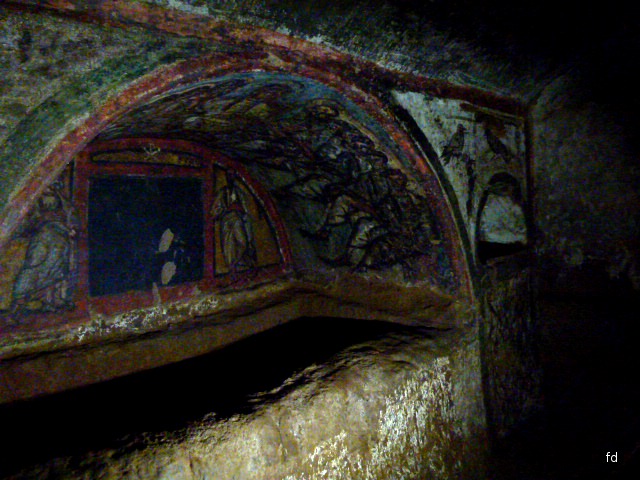Catacomb Of Domitilla on:
[Wikipedia]
[Google]
[Amazon]
The Catacombs of Domitilla are an underground Christian cemetery named after the Domitilla family that had initially ordered them to be dug. They are located in
 The catacombs are composed of
The catacombs are composed of
Rome
, established_title = Founded
, established_date = 753 BC
, founder = King Romulus (legendary)
, image_map = Map of comune of Rome (metropolitan city of Capital Rome, region Lazio, Italy).svg
, map_caption ...
, Italy
Italy ( it, Italia ), officially the Italian Republic, ) or the Republic of Italy, is a country in Southern Europe. It is located in the middle of the Mediterranean Sea, and its territory largely coincides with the homonymous geographical ...
. They are situated over 16 metres underground, about 2 kilometers from the south of Appia Antica (Appian Way) and span 15 kilometers in distance. They were actively used as a cemetery from the first through the fifth centuries AD and were rediscovered in 1593 by Antonio Bosio, an archaeologist They include more than 26,000 tombs. More recently, they have been restored using lasers, giving a much clearer view of the images on the walls. Unlike other Roman catacombs, these catacombs still hold the remains of humans.
Renovation
 The catacombs are composed of
The catacombs are composed of tufa
Tufa is a variety of limestone formed when carbonate minerals precipitate out of water in unheated rivers or lakes. Geothermally heated hot springs sometimes produce similar (but less porous) carbonate deposits, which are known as travertin ...
, a form of limestone that is porous. Finishing in 2017, restorers used lasers to help restore two rooms. The restorers worked to remove layers of algae, smoke deposits, and a chalky substance. What was revealed were both pagan and Christian inspired frescoes. So far, only 12 out of about 70 rooms have been restored.
Wall paintings
Inside the Catacombs of Domitilla are images, some of which were revealed by the restoration, reflecting the life of bakers, grape vines, Jesus with the apostles,Noah's ark
Noah's Ark ( he, תיבת נח; Biblical Hebrew: ''Tevat Noaḥ'')The word "ark" in modern English comes from Old English ''aerca'', meaning a chest or box. (See Cresswell 2010, p.22) The Hebrew word for the vessel, ''teva'', occurs twice in ...
, and Daniel with the lions. Other biblical figures in the various cubicula include the Virgin Mary with child, Adam, Eve, Jonah
Jonah or Jonas, ''Yōnā'', "dove"; gr, Ἰωνᾶς ''Iōnâs''; ar, يونس ' or '; Latin: ''Ionas'' Ben (Hebrew), son of Amittai, is a prophet in the Hebrew Bible and the Quran, from Gath-hepher of the northern Kingdom of Israel (Samaria ...
, The Good Shepherd, a young man dressed as a cardinal with apostles Peter and Paul. Non-biblical, or pagan, figures include representations of Spring and Summer in the form of females with wings, both pictured with attendants and scenes depicting Orpheus
Orpheus (; Ancient Greek: Ὀρφεύς, classical pronunciation: ; french: Orphée) is a Thracian bard, legendary musician and prophet in ancient Greek religion. He was also a renowned poet and, according to the legend, travelled with J ...
surrounded by birds, beasts and the sheep that typically accompany him. There are also other images of mythological and wild or tame beasts beyond the depictions of Orpheus.
See also
*Domitilla the Younger
Flavia Domitilla the Younger or Flavia Domitilla Minor (c. 45 – c. 66) was the only daughter of the Roman Emperor Vespasian.
Biography
She was the child of Vespasian and his wife Domitilla the Elder. She was born after her brother Titus a ...
* Flavia Domitilla (wife of Clemens)
Flavia Domitilla was a Roman noblewoman of the 1st century. She was a granddaughter of Emperor Vespasian and a niece of Emperors Titus and Domitian. She married her cousin, the consul Titus Flavius Clemens, a grand-nephew of Vespasian through his ...
References
External links
* Catacombs Flavian dynasty {{Rome-stub